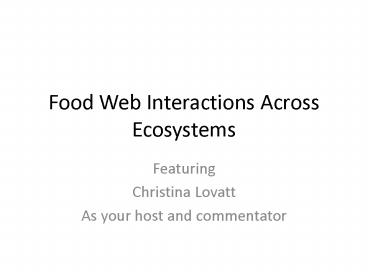Food Web Interactions Across Ecosystems PowerPoint PPT Presentation
1 / 24
Title: Food Web Interactions Across Ecosystems
1
Food Web Interactions Across Ecosystems
- Featuring
- Christina Lovatt
- As your host and commentator
2
Introduction
- Ecosystem Linkages Movements of nutrients,
detritus, and organisms among habitats connect
landscapes and influence the dynamics and
structure of communities (Polis et al. 1997) - Strongest effects at the boundary between
habitats (Murakami and Shigeru, 2002) - Freshwater habitats often have a large
perimeterarea ratio. Therefore sites of strong
interactions with the surrounding landscape.
3
- Specific Investigations in Food Web Linkages
between ecosystems - Mechanisms of Interaction
- Strength of Interaction
- Extent of Direct and Indirect Effects In
Connected Food webs
4
- Trophic cascade the indirect effects of
predators on plants via herbivores (Shurin et al.
2002) or - When predators reduce prey abundances, relaxing
consumption at lower trophic levels
The strength of the effect varies between
ecosystems.
5
Species with complex life histories often move
between habitats during their lifecycle,
participating in food webs of multiple ecosystems
This is one mechanism of connectivity between
freshwater habitats and their surrounding
http//www.thebowriver.com/alberta/may_fly_life_cy
cle.jpg
6
Indirect effect of aquatic insect emergence on a
terrestrial insect population through by birds
predation
- Murakami, M. and Nakano, S. 2002. Ecology
Letters. 5 333-337
7
Examined the effects of bird predators attracted
and subsidized by aquatic insect emergence on the
local terrestrial insect population
- Early spring terrestrial productivity very low,
but aquatic productivity at its peak - Aquatic insects emerge from stream, birds depend
on them as food source - Bird distribution higher around stream
- Top-down control of herbivorous insects by birds
8
The Site
- Horonai Stream, Tomakomai Experimental Forest in
Japan - 3 plots each in riparian and upland forest
http//forest.fsc.hokudai.ac.jp/exfor/Toef/image/
position_toef_e.JPG
9
The Experiment
- Japanese Lilac dominates shrub layer
- First species to break bud in the spring
www.cirrusimage.com/tree_Japanese_tree_lilac.htm
- Infected by Leaf Roller moths
- Early spring, birds concentrate foraging on Lilac
trees
organicgardensite.com/bugs-harmful/leaf-rollers/
10
- Observed 3 primary species of insectivorous birds
Great Tit
Crowned willow warbler
Marsh tit
- Utilise Leaf rollers, aquatic, and terrestrial
insects
www.worcesterbirding.co.uk/49.html
animalpicturesarchive.com/view.php?tid5did4685
www.naturephoto-cz.com/great-titparus-major-...
11
- For riparian vs. upland forest
- Distribution and abundance of insectivorous
birds - Proportion of prey types eaten by birds
- Herbivorous insects
- Other terrestrial insects
- Aquatic insects
- Abundance of terrestrial vs. aquatic insects
- Depression of terrestrial insect population due
to bird predation
12
- Monitored
- bird visitation rate to sites (visits per hr)
- prey utilisation (leaf rollers, terrestrial or
aquatic insects) - Tested
- Insect abundance at sites via traps
- Sorted into terrestrial and aquatic
- Experimented
- Excluded birds from randomly selected lilacs with
nylon-mesh net - Compared numbers of dominant leaf roller sp. with
control lilacs
13
Results
- Leaf Rollers made up a smaller proportion of
prey in riparian sites, but overall predation on
Leaf Rollers was higher due to greater visitation
frequency
Not sig. different
- Great Tits and Warblers visited riparian sites
significantly more frequently than upland sites.
Visitation rates were higher to riparian sites
14
- Numbers decreased due to bird predation
especially in the riparian plots
- Aquatic prey much more available in the riparian
plots
15
What it all means
Predator Insectivorous Bird
Direct Predation Effects
Direct Predation Effects
Indirect Apparent Competition Effects
Prey Sp. 2 Leaf Roller
Prey Sp. 1 Emergent Aquatic Insect
- Prey subsidies from the stream ecosystem to the
terrestrial system had an indirect effect on
terrestrial prey by increasing predator abundance
16
Trophic Cascades Across Ecosystems
- Knight , T.M., McCoy, M.W., Chase, J.M., McCoy,
K.A., and Holt, R.D. 2005. Nature. 437880-883
17
Knight et al. examined the indirect facilitation
of plant reproduction by fish, via dragonfly
predation on pollinators, and altered pollinator
feeding behaviour
Pollinator
Dragonfly
Dragonfly Larva
Fish
Terrestrial
Aquatic
18
The Site
Hypothesis
Fish reduce larval and adult dragonfly
abundances, permitting a higher abundance of
pollinating insects, indirectly increasing the
reproductive success of nearby terrestrial plants
- University of Floridas Katharine Ordway
Preserve, Carl Swisher Memorial Sanctuary - Four ponds with fish, four without (no systematic
differences between the groups)
19
- For fish vs. fishless ponds
- Abundance and size distribution of larval and
adult dragonflies - Pollinator visitation rates to St. Johns wort
- Assessed pollen limitation by St. Johns wort
- Observed pollinator behaviour in the presence of
a predator
20
The Experiment
- Observed
- Dragonflies (larvae and adults)
- Abundances
- Size distribution
- Pollinators
- Visitation rates
- Species composition
- Experimented
- Pollen supplementation on St. Johns Wort,
(determine reproductive limitation by lack of
pollination) - Trapped dragonflies in cages (allowed pollinators
free access) with St. Johns wort and monitored - Pollinator visitation
- Number of flowers visited
21
Results
- Dragonfly larvae adults more abundant and
bigger around ponds without fish (blackbig,
greymed. Whitesmall)
22
- Pollinator visits to St. Johns wort much lower
around ponds with fish. BlackDiptera,
GreyLepidopter, White bees
- Pollen limitation much greater in shrubs around
ponds with fish
23
- Pollinators visit sig. more flowers when predator
is absent then when it is present
- What it all means...
Hypothesis confirmed! Fish indirectly improve
plant reproductive success via consumption of
pollinator predators
24
General Conclusions
- Species with complex life histories play an
important role in linking freshwater habitats to
their surroundings - Linkages between food webs and ecosystem
processes can have strong indirect effects on
community dynamics and structure - Determining the existence, mechanisms and
relative strengths of these interactions should
be the focus of future research, and will be
integral to effective management of landscapes.

